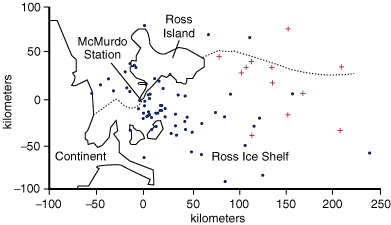


Approximate landing sites of 91 rawinsondes launched from McMurdo
Station between February 1 and October 29, 1991 (filled circles); and known landing sites of
12 high-value ozonesondes launched during August, September, and October 1992
(+).

Does the fate of research balloons in Antarctica constitute a significant impact on the environment?

Scientists at Oak Ridge National Laboratory evaluated potential effects of balloon operations by the U.S. Antarctic Program. They found that in one important respect there may be a real environmental concern regarding the use of balloons in Antarctica.
The cumulative annual releases of balloons from all stations in the Antarctic probably number in the thousands. Because many of the world's great whales, all of which are endangered, frequent Antarctic waters, they are susceptible to the ingestion of plastic and other synthetic materials that are present. A simple model was developed to predict the frequency of encounters with balloons on individual and population bases.
Although the inadequacy of currently available data dictated the use of several conservative assumptions, the resulting whale/balloon encounter frequencies were so high (in the thousands per year in some scenarios), that application of even very low fatality-to- encounter ratios resulted in predictions of losses of these endangered animals.

McCold, L. N., G. K. Eddlemon, and T. J. Blasing. 1994. Environmental effects of the U.S. Antarctic Program's use of balloons in Antarctica. Oak Ridge National Laboratory, Oak Ridge, Tenn. (in preparation).
Integrated Assessment Briefs. 1995. ORNL/M-4227. Oak Ridge National Laboratory, Oak Ridge, TN.